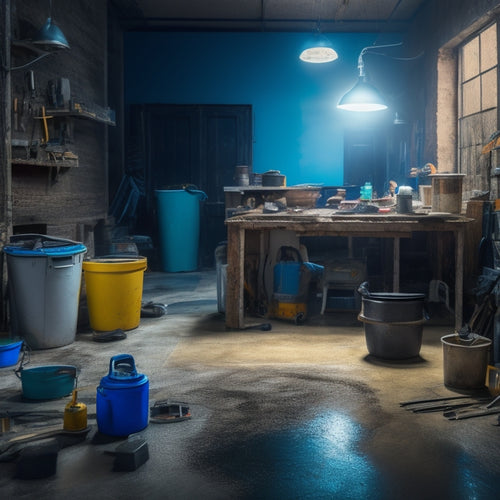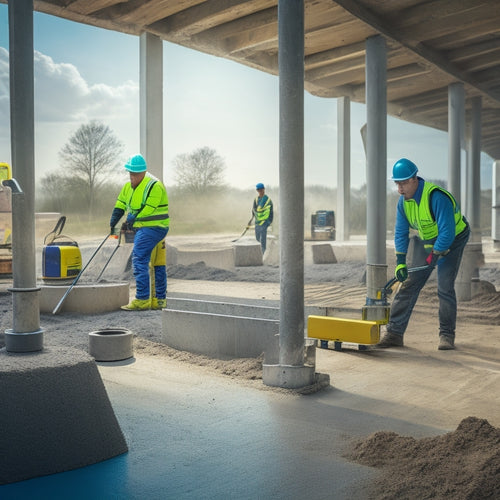
Why Choose the Right Tools for Concrete Sealing
Share
When it comes to concrete sealing, choosing the right tools can make all the difference. You'll greatly increase your chances of a successful project by selecting the appropriate tools and techniques, as the wrong ones can lead to compromised adhesion, uneven finishes, and reduced durability. With the right tools, you'll be able to properly prepare the surface, apply sealant evenly, and achieve a professional finish. From handheld sprayers to rollers, and from crack repair to substrate evaluation, each tool plays a critical role in the process. By understanding the importance of each tool, you'll be well on your way to a successful concrete sealing project that meets your needs and exceeds your expectations.
Key Takeaways
• The right tools ensure efficient application, saving time and labor costs for concrete sealing projects.
• Handheld, backpack, and cart-mounted sprayers cater to different project sizes and requirements.
• Proper tool selection enables the achievement of desired finishes, such as flooding, misting, or fogging.
• High-quality tools and techniques prevent common application errors, like puddling and uneven coverage.
• Investing in the right tools leads to a professional finish, enhancing the durability and appearance of sealed concrete.
Essential Tools for Sealing Concrete
Selecting the right tools for sealing concrete is essential, as it directly impacts the quality and longevity of the sealant application. Having the necessary tools at your disposal guarantees a professional-grade finish.
You'll need to take into account the type of sprayer that suits your project's requirements. There are various sprayer types, including handheld, backpack, and cart-mounted sprayers, each designed for specific applications and coverage areas. For instance, handheld sprayers are ideal for small to medium-sized projects, while backpack sprayers are better suited for larger areas.
It's also important to master various application techniques, such as flooding, misting, and fogging, to achieve the best results. Flooding involves applying a thick, even coat, while misting and fogging are used for more delicate applications.
Importance of Surface Preparation
Before you start applying sealant, you'll need to verify the concrete surface is properly prepared, as even the best sealant can't compensate for a poorly prepared surface, and a thorough cleaning and repair of cracks and joints is vital to achieving a strong, long-lasting bond.
Proper surface preparation involves evaluating the substrate to identify any defects or contaminants that may affect the sealant's adhesion. This includes examining the surface cleanliness, porosity, and texture. A clean and dry surface is essential, as any dirt, oil, or moisture can compromise the bond between the sealant and concrete.
Here's a breakdown of the key surface preparation steps:
| Step | Description | Importance |
|---|---|---|
| Cleaning | Remove dirt, oil, and other contaminants | Guarantees strong bond between sealant and concrete |
| Repairing cracks and joints | Fill gaps and cracks to prevent water infiltration | Prevents water damage and guarantees structural integrity |
| Substrate evaluation | Evaluate surface porosity, texture, and defects | Identifies potential issues that may affect sealant adhesion |
Sealant Application Made Easy
With your properly prepared surface in hand, you're now ready to apply the sealant. By following a few simple guidelines, you can guarantee a smooth, even, and effective application process.
First, choose the right application tool for the job. Spray techniques are ideal for large, open areas, while roller options are better suited for smaller, more intricate spaces.
When using a sprayer, maintain a consistent distance from the surface and move in a steady, back-and-forth motion to prevent puddling. For rollers, select the correct nap length and apply moderate pressure, working in sections to maintain even coverage.
Regardless of the tool, always work in thin, even coats, allowing each layer to dry according to the manufacturer's instructions before applying the next. This will prevent pooling and ascertain a uniform finish.
Choosing the Right Sealant Type
You'll need to take into account several factors, including the type of concrete, environmental conditions, and desired finish, when determining the right sealant type for your specific project. This is essential, as different sealant types have distinct performance characteristics that can greatly influence the outcome of your concrete sealing job.
Some key considerations when choosing a sealant type include:
-
Chemical resistance: Will the sealant be able to withstand exposure to harsh chemicals or heavy foot traffic?
-
UV stability: How well will the sealant hold up to direct sunlight and outdoor exposure?
-
Slip resistance: Is a textured, non-slip finish required for safety reasons?
Protective Gear for Safety
As you prepare to seal your concrete, you're probably thinking about the type of sealant to use, but don't forget about your safety equipment.
You'll need protective clothing to avoid skin irritation, respiratory issues, and other health hazards associated with concrete sealing. Invest in high-quality safety equipment, including gloves, goggles, and a face mask. These will protect you from harsh chemicals and flying debris.
Make sure your protective clothing is breathable, waterproof, and resistant to abrasion. A good pair of steel-toed boots will also protect your feet from heavy objects and sharp edges.
Don't take shortcuts when it comes to your safety – it's better to be over-prepared than to risk injury or illness. Remember, safety equipment is an essential tool in your concrete sealing arsenal.
Achieving a Professional Finish
When you're sealing concrete, achieving a professional finish requires attention to detail and a solid understanding of the process.
You'll need to guarantee the surface is properly prepared, apply the sealant evenly, and finish with a flourish to get the results you want.
Proper Surface Prep
Prepare the concrete surface by meticulously cleaning it to remove dirt, oil, and other contaminants that can interfere with the sealer's adhesion, guaranteeing a strong bond and a professional-looking finish.
You'll want to eliminate any surface contaminants that could compromise the sealer's performance. This vital step sets the stage for a successful sealing process.
Here are some key considerations to keep in mind:
-
Remove dirt and debris: Sweep or blow away loose particles, and then mop or pressure wash the surface to remove dirt and grime.
-
Check for oil and grease: Identify and remove any oil or grease spots, as they can prevent the sealer from bonding properly.
-
Monitor substrate moisture: Confirm the concrete substrate is dry, as excess moisture can affect the sealer's adhesion and overall performance.
Even Application Matters
To achieve a professional-looking finish, you'll need to apply the sealer evenly, using techniques that guarantee consistent coverage and a uniform sheen. This is where your chosen tools really come into play.
When it comes to even application, spray techniques are often the way to go. By using a high-quality sprayer, you can achieve a fine, consistent mist that coats the concrete surface evenly.
However, for larger areas or more textured surfaces, roller application may be a better option. In this case, make certain to choose a roller with the right nap length and material to guarantee a smooth, even finish.
Regardless of the method you choose, it's crucial to work in sections, dividing the concrete surface into manageable areas to maintain even coverage. This will help you avoid streaks, puddles, and other imperfections that can detract from the final result.
Finishing Touches Count
How do you guarantee a flawless finish that showcases your hard work and attention to detail? Achieving a professional finish requires more than just applying a concrete sealer. It's about paying attention to the little things that set your work apart from the rest.
To assure a flawless finish, consider the following:
-
Choose the right applicator: Using the right applicator can make a huge difference in the final result. Microfiber rollers, for instance, are ideal for applying sealers evenly and smoothly.
-
Don't forget the edges: Pay attention to the edges, corners, and crevices where the sealer can pool and create unevenness. Use a small brush or a precision applicator to get into these tight spaces.
-
Add a decorative touch: Consider adding a decorative finish, such as a non-slip texture or a glossy coat, to give your concrete surface an extra layer of protection and visual appeal.
Frequently Asked Questions
Can I Use a Regular Paintbrush for Applying Concrete Sealant?
You shouldn't use a regular paintbrush for applying concrete sealant, as it'll lead to uneven coverage and pooling. Instead, opt for a high-quality, sealant-specific brush with the right application techniques and brush types for a smooth, professional finish.
Do I Need to Seal My Concrete Driveway Every Year?
You'll be sealing your concrete driveway until the end of time if you don't get it right! Fortunately, you don't need to seal it every year; consider cost considerations and sealing frequency, typically every 2-5 years, depending on traffic and climate.
Is It Necessary to Seal Concrete in Shaded Areas?
When you're dealing with shaded areas, you'll want to seal your concrete to prevent moisture retention, which can lead to damage and cracking, as shaded spots are more prone to water accumulation and slower evaporation.
Can I Mix Different Types of Concrete Sealants Together?
When mixing different types of concrete sealants, you'll need to guarantee sealant compatibility, as incompatible blends can compromise performance. Research recommended mixing methods and ratios to avoid adverse reactions, and always follow manufacturer guidelines.
Will Sealing Concrete Make It Slip-Resistant?
'You'll be surprised to know that over 25% of concrete floors are slippery! Sealing concrete can indeed make it slip-resistant, as it enhances traction and reduces the risk of accidents, offering an essential sealing benefit for safety-conscious individuals like you.'
Conclusion
You've made it this far, so you're clearly invested in getting the job done right.
But you might be thinking, 'Is all this fuss about tools and preparation really necessary?' The answer is, absolutely.
Skipping even one essential step can lead to a subpar finish, wasted materials, and a whole lot of frustration.
By choosing the right tools and following best practices, you'll save time, money, and your sanity in the long run.
So, take the extra effort to get it right – your concrete will thank you.
Related Posts
-

Essential Tools for Epoxy Concrete Floor Repair
You'll need a thorough arsenal of specialized tools to guarantee a successful epoxy concrete floor repair. Floor prep...
-

5 Best Tools for Stamping Concrete Walls
When it comes to stamping concrete walls, you'll need a range of specialized tools to achieve the desired texture and...
-

What Tools Ensure Precise Concrete Leveling Results
You need a range of specialized tools to achieve precise concrete leveling results. Laser leveling instruments provid...


